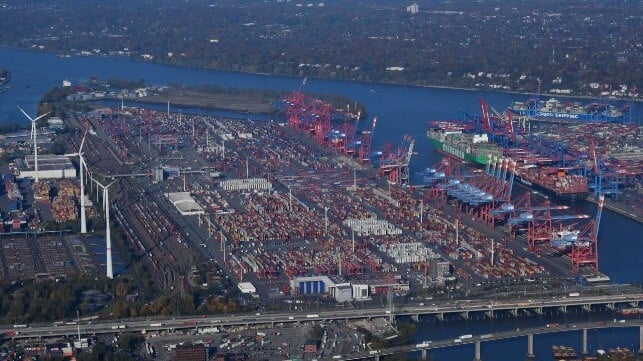Hamburg Gets More Big Ships but Geopolitics/Economy Drive Volume Down

The Port of Hamburg, traditionally one of the busiest in the world, experienced a decline in volumes in nearly all categories in 2022 like many other ports around the world. While the port was impacted by the slowing in the global economy, it also pointed to the direct impact due to the global political situation. Near-term, they point to similar levels of uncertainty impacting the port’s outlook while they continue to develop plans for hydrogen and other future growth opportunities.
“The war in Ukraine plus the related sanctions against Russia, along with worldwide supply chain problems caused by the corona pandemic, impacted Port of Hamburg throughput during the year,” explained Axel Mattern, Port of Hamburg Marketing’s CEO. “This was compounded by labor disputes in the port at the beginning of the second half of the year and very high inflation in the course of the autumn, which caused consumer spending to fall to a low point.”
Hamburg’s total seaborne cargo throughput was now nearly seven percent for all of 2022 with just under 120 million tons. While the port experienced a positive trend in conventional general cargo, other segments including bulk cargoes and containers were off. TEU volume fell just over five percent to 8.3 million TEU while bulk cargo was overall off by nearly nine percent with the port blaming stiffer sanctions against Russia.
While volumes declined port calls and especially by increasingly larger container vessels were up for the year. The Megamax class, vessels over 18,000 TEU, were up six percent and with companies including Hapag-Lloyd deploying new 24,000 TEU vessels starting later this year the trend is likely to only accelerate for the port. Similar growth was also reported for vessels over 14,000 TEU while the category between 10,000 and 13,999 TEU showed the largest decline of 16.6 percent for the year. Smaller containerships below 10,000 TEU also grew although the port said that small containerships and feeder vessels were arriving less often in the second half of 2022.
Reflecting some of the strength in the smaller size vessel categories, Hamburg also reported strong growth in throughput with both the nearby ports in Poland and Finland. They also reported positive trade growth with Canada, although China remains their largest trade partner accounting for 30 percent of the container volume for the year. The U.S. was the second largest trade partner with loaded boxes rising nearly one percent with the U.S. but overall accounted for just over seven percent of the total volume.
“With Christmas coming, in the final quarter we should normally see a rise in throughput totals,” explained Mattern. “That failed to happen last year. The main reasons were high energy costs and inventories in industry.”
The continuing uncertain situation on world markets makes it hard to deliver a forecast for the year 2023 the port noted. “We hope the global economy will again recover. That will aid and boost throughput for the Port of Hamburg,” concluded Mattern.
Near-term the port highlights further efforts at improving the approaches to Hamburg which will help more large vessels to enter the port. They are also working toward the future pointing to efforts to develop Hamburg as an energy hub building the infrastructure for a comprehensive hydrogen value chain. Using its agreements with Canada and elsewhere, Germany looks to build a hydrogen import industry creating alternative fuel supplies for industry and providing strong energy independence in the future.
